
A synagogue, sometimes referred to as a shul or a temple, is a house of worship in Judaism. Synagogues have a place for prayer where Jews attend religious services or special ceremonies such as weddings, b'nai mitzvah, choir performances, and children's plays. They also have rooms for study, social halls, administrative and charitable offices, classrooms for religious and Hebrew studies, and many places to sit and congregate. They often display commemorative, historic, or modern artwork alongside items of Jewish historical significance or history about the synagogue itself.

Subotica is a city and the administrative center of the North Bačka District in the autonomous province of Vojvodina, Serbia. Formerly the largest city of Vojvodina region, contemporary Subotica is now the second largest city in the province, following the city of Novi Sad. According to the 2022 census, the city itself has a population of 94,228, and the population of metro area stands at 123,952 people.

The North Bačka District is one of seven administrative districts of the autonomous province of Vojvodina, Serbia. It lies in the Bačka geographical region. According to the 2022 census results, it has a population of 160,163 inhabitants. The administrative center of the district is the city of Subotica.

Łańcut County is a unit of territorial administration and local government (powiat) in Subcarpathian Voivodeship, south-eastern Poland. It came into being on January 1, 1999, as a result of the Polish local government reforms passed in 1998. Its administrative seat and only town is Łańcut, site of the famous Łańcut Castle, lying 17 kilometres (11 mi) east of the regional capital Rzeszów.

Ada is a town and municipality located in the North Banat District of the autonomous province of Vojvodina, Serbia. It is situated near the river Tisa in the geographical region of Bačka. The town has a population of 9,564, while the municipality has 16,991 inhabitants, and a 75.04% Hungarian majority.

Erzsébetváros is the 7th district of Budapest, situated on the Pest side of the Danube. The inner half of the district was the historic Jewish quarter of Pest. The Dohány Street Synagogue, the largest functioning synagogue in Europe, is located in this district. Currently it is the most densely populated district of Budapest with 29,681.3 person per km2. In 1910 Erzsébetváros had 152,454 inhabitants. During the socialist era Erzsébetváros's population decreased rapidly, because young people and families moved to the newer "panelized" boom districts. Gentrification and recovery started in the middle of the 2000s.

Sukkat Shalom Synagogue or Belgrade Synagogue is the only fully active Jewish place of worship in Serbian capital Belgrade, although there are other synagogue buildings in the city. It is located in central Belgrade, near Obilićev Venac Square and central high street Knez Mihailova.

Moorish Revival or Neo-Moorish is one of the exotic revival architectural styles that were adopted by architects of Europe and the Americas in the wake of Romanticist Orientalism. It reached the height of its popularity after the mid-19th century, part of a widening vocabulary of articulated decorative ornament drawn from historical sources beyond familiar classical and Gothic modes. Neo-Moorish architecture drew on elements from classic Moorish architecture and, as a result, from the wider Islamic architecture.

Serbia has been traditionally a Christian country since the Christianization of Serbs by Clement of Ohrid and Saint Naum in the 9th century. The dominant confession is Eastern Orthodoxy in the fold of Serbian Orthodox Church.

The history of the Jews in Croatia dates back to at least the 3rd century, although little is known of the community until the 10th and 15th centuries. According to the 1931 census, the community numbered 21,505 members, and it is estimated that on the eve of the Second World War the population was around 25,000 people. Most of the population was murdered during the Holocaust that took place on the territory of the Nazi puppet state called the Independent State of Croatia. After the war, half of the survivors chose to settle in Israel, while an estimated 2,500 members continued to live in Croatia. According to the 2011 census, there were 509 Jews living in Croatia, but that number is believed to exclude those born of mixed marriages or those married to non-Jews. More than 80 percent of the Zagreb Jewish Community were thought to fall in those two categories.

The history of the Jews in Serbia is some two thousand years old. The Jews first arrived in the region during Roman times. The Jewish communities of the Balkans remained small until the late 15th century, when Jews fleeing the Spanish and Portuguese Inquisitions found refuge in the Ottoman-ruled areas, including Serbia.

The Jewish people of Bosnia and Herzegovina are one of the minority peoples of Bosnia and Herzegovina, according to country's constitution. The history of Jews in Bosnia and Herzegovina spans from the arrival of the first Bosnian Jews as a result of the Spanish Inquisition to the survival of the Bosnian Jews through the Holocaust and the Yugoslav Wars. Judaism and the Jewish community in Bosnia and Herzegovina have one of the oldest and most diverse histories of all the former Yugoslav states, and is more than 500 years old, in terms of permanent settlement. Then a self-governing province of the Ottoman Empire, Bosnia was one of the few territories in Europe that welcomed Jews after their expulsion from Spain.

Belgrade, Serbia has an abundance of religious architecture. The city has numerous Serbian Orthodox churches and temples and it is also the seat of the Patriarch of the Serbian Orthodox Church. Its two most prominent Orthodox Christian places of worship are the Saborna Crkva and the Temple of St. Sava, the largest Eastern Orthodox church in the world.

Novi Sad Synagogue is one of many cultural institutions in Novi Sad, Serbia, in the capital of Serbian the province of Vojvodina. Located on Jevrejska (Jewish) Street, in the city center, the synagogue has been recognized as a historic landmark. It served the local Neolog congregation.

The history of the Jews of Montenegro dates back to the times when that area was connected to the division of the Roman Empire between Roman and Byzantine rule. Since modern-day Montenegro is a young country the Jewish community of Montenegro is the youngest and one of the smallest Jewish communities in the world. The decision on forming a formal community was made in June 2011 at the home of Mrs. Đina Lazar in Herceg Novi. At the end of July of the same year, the community was registered as a citizens' association and thus gained certain legal legitimacy. Very soon after registering, the Chief Rabbi of Israel Rabbi Yona Metzger visited Montenegro and the Jewish community. Rabbi Metzger, along with escorts and leading members of the community, was received by the most important state officials: the Presidents of the State, the Parliament and the Government.

The Jakab and Komor Square Synagogue in Subotica is a Hungarian Art Nouveau synagogue in Subotica, Serbia. It is the second largest synagogue in Europe after the Dohány Street Synagogue in Budapest. It was built in 1901–1902 during the administration of the Kingdom of Hungary, according to the plans of Marcell Komor and Dezső Jakab replacing a smaller and less elaborate synagogue. It is one of the finest surviving pieces of religious architecture in the art nouveau style. It served the local Neolog community.

The Cathedral of the Transfiguration of the Lord is a Serbian Orthodox cathedral located on the Petar Preradović Square in Zagreb, Croatia. It was built in 1865–66 according to designs of architect Franjo Klein. It is ecclesiastically part of the Metropolitanate of Zagreb and Ljubljana and is known as the Zagreb Orthodox Cathedral.

The Holocaust in the Independent State of Croatia involved the genocide of Jews, Serbs and Romani within the Independent State of Croatia, a fascist puppet state that existed during World War II, led by the Ustaše regime, which ruled an occupied area of Yugoslavia including most of the territory of modern-day Croatia, the whole of modern-day Bosnia and Herzegovina and the eastern part of Syrmia (Serbia). Of the 39,000 Jews who lived in the NDH in 1941, the United States Holocaust Memorial Museum states that more than 30,000 were murdered. Of these, 6,200 were shipped to Nazi Germany and the rest of them were murdered in the NDH, the vast majority in Ustaše-run concentration camps, such as Jasenovac. The Ustaše were the only quisling forces in Europe who operated their own extermination camps for the purpose of murdering Jews and members of other ethnic groups.






























